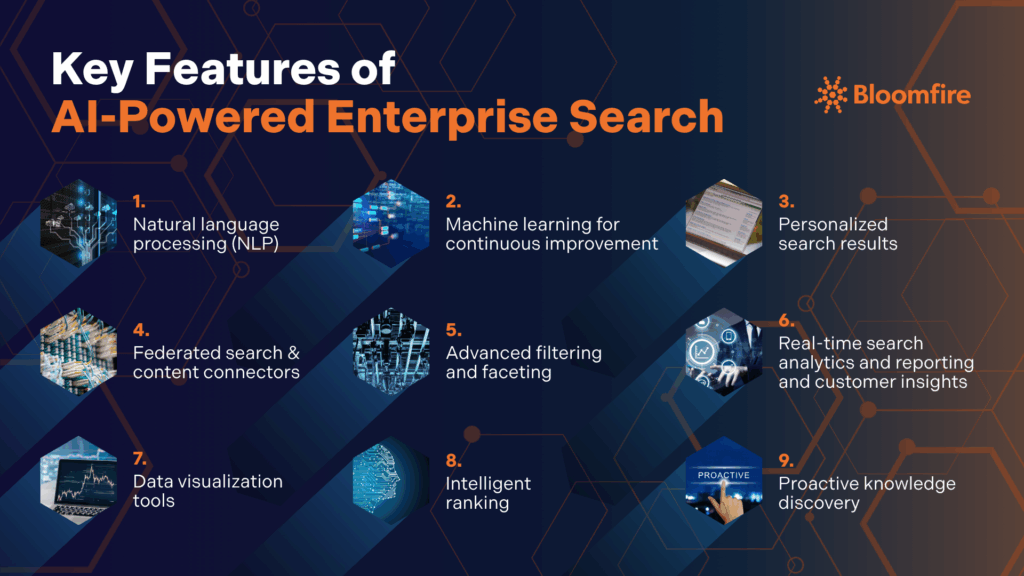9 Enterprise AI Search Features That Drive Innovation

The evolution of search technologies has led to the development of sophisticated Enterprise artificial intelligence (AI) search solutions, which can understand context and semantics, delivering more accurate and relevant results. These advanced enterprise AI search features are becoming increasingly essential for organizations seeking to optimize their operations and enhance decision-making processes.
As you explore the potential of Enterprise AI search, you’ll discover how it can revolutionize your business practices by streamlining access to information and fostering innovation. In doing so, it is crucial to understand which features support these outcomes and how they promote innovation within your organization.
Highlights
- AI enterprise search solutions provide a comprehensive suite of advanced features, including natural language processing (NLP), machine learning, personalized results, and advanced filtering.
- The system also has federated search, real-time analytics, intelligent ranking, and proactive knowledge discovery.
- When choosing an enterprise AI search solution, prioritize scalability, advanced AI features, robust integrations, an intuitive user experience with customization, and a reputable vendor.
Key Features of AI-Powered Enterprise Search
AI-powered enterprise search solutions offer a range of advanced features that set them apart from traditional search engines. These capabilities enable more intuitive, accurate, and insightful information discovery. Here are the key features of an internal AI enterprise search system.

1. Natural language processing (NLP)
Natural language processing (NLP) enables the AI search engine to understand and interpret language in a way that truly mimics human comprehension. Users can enter queries conversationally, asking full questions or using nuanced phrases, rather than being limited to precise keywords.
The system then grasps the underlying intent of the query, not just the words themselves, leading to significantly more intuitive and accurate search results. It makes the search experience feel less like a rigid database query and more like a natural conversation with an expert.
This deep linguistic understanding is a potent driver of innovation within organizations. When employees can effortlessly find precise information, regardless of how they phrase their queries, it dramatically accelerates the pace of research and decision-making.
For instance, a marketing team can quickly identify emerging sentiment around a new product launch, or a legal department can instantly pinpoint relevant clauses across thousands of contracts. Rapidly extracting actionable insights from vast amounts of unstructured and structured data connects previously disparate pieces of information. This fosters a deeper and more contextual understanding of organizational knowledge.
Empower Your Enterprise
Boost productivity and insights. Discover smarter search with Bloomfire AI.
Explore Bloomfire
2. Machine learning for continuous improvement
These systems are inherently designed to learn and adapt over time, a crucial differentiator from static, traditional search. Leveraging machine learning algorithms, AI enterprise search solutions continuously refine their performance in semantic search. They do this by analyzing various factors, including user interactions, the relevance of search results as indicated by user engagement (e.g., clicks, time spent on documents), and explicit feedback.
As the search system becomes more intelligent and attuned to the nuances of user queries and content relevance, it empowers employees, like customer service agents, to find obscure or previously undiscoverable insights hidden within vast datasets. This ability to quickly unearth connections and patterns that humans might miss fosters a culture of informed experimentation and accelerated problem-solving.
A recent survey by Gartner revealed that 59% of organizations have adopted machine learning methods to enhance their operational strategies. This leads to improved accuracy in forecasting and understanding market trends.
3. Personalized search results
AI algorithms analyze individual user behavior, roles, and past interactions to tailor search results specifically to them, ensuring the delivery of highly relevant information. For instance, a sales representative might review client documents and product information, while an engineer would receive design specifications and technical manuals.
The system learns from every click, every query, and every document viewed, continuously refining its understanding of individual needs and preferences. This dynamic adaptation ensures that the information presented is not only relevant to the search query but also to the user’s specific workflow and objectives.
4. Federated search & content connectors
This critical feature of AI enterprise search solutions enables the seamless integration and indexing of data from a vast array of disparate enterprise sources. Imagine all your organizational knowledge, regardless of where it resides–in databases, various cloud storage solutions, content management systems, internal wikis, CRM platforms, ERP systems, shared drives, and even emails–under one unified search experience.
Having comprehensive connectivity eliminates the notorious information silos that plague many large organizations. It also allows users to find critical information without having to switch between numerous applications or struggle with fragmented data.
A report by Forrester Research indicates that knowledge workers spend an average of 12 hours a week chasing data due to fragmented information across disparate systems. Federated search directly addresses this inefficiency, ensuring that all relevant information is easily discoverable and accessible.
Access to this holistic view of an organization’s knowledge base fosters cross-departmental collaboration and understanding, accelerates research and development, and enables employees to connect seemingly unrelated pieces of information. It enhances visibility, leading to the identification of new opportunities and the accelerated development of innovative products, services, and processes.
For instance, a user might search for “marketing strategy documents” and then apply facets to narrow the results to “presentations,” “created in the last 6 months,” and “authored by the product team.” This level of granular control over search results empowers employees to uncover highly specific information that might otherwise remain buried within vast data repositories.
5. Advanced filtering and faceting
This feature offers powerful tools to refine search results using various criteria such as date range, file type, author, department, project, and even custom metadata, enabling precise information drill-down. Instead of sifting through thousands of broadly relevant documents, users can quickly narrow down their search to find exactly what they need.
The speed of locating information is a hallmark of a robust knowledge management system, further enhanced by AI enterprise search. Our Value of Enterprise Intelligence Report highlights that organizations with strong knowledge management programs experience a 60.5% faster rate in making critical decisions and a 31% increase in overall decision-making speed.
The accelerated decision velocity, fueled by immediate access to highly filtered and relevant information, is a direct catalyst for innovation. This enables teams to iterate faster, respond to market changes more swiftly, and develop groundbreaking solutions.
6. Real-time search analytics and reporting
The ability to derive immediate insights from search data is a significant driver of innovation. Organizations can swiftly understand new research interests, identify unforeseen connections between different datasets, and recognize emerging market or customer trends reflected in search queries.
Real-time search analytics and reporting serve as a powerful feedback loop, providing an immediate pulse on what knowledge users are seeking, what they are finding (or not finding), and how they are interacting with the enterprise search platform. Observing these patterns in real-time allows organizations to identify emerging knowledge needs, detect deficiencies in existing documentation, and pinpoint areas where information is either missing or difficult to locate.
7. Data visualization tools
Visual clarity significantly reduces the cognitive load on users, allowing them to grasp complex information at a glance and make quicker, more confident decisions. This is where data visualization tools become highly valuable.
This powerful capability helps users quickly identify trends, patterns, and relationships within their data that might otherwise be hidden in raw text or numerical tables. It transforms complex information into easily digestible visual narratives, making data more accessible and understandable to a broader audience, regardless of their technical expertise.
Data visualization fosters a culture of data-driven decision-making, encouraging exploratory analysis and enabling teams to collaborate more effectively on shared insights. For instance, a report from MoldStud highlights that visual announcements can lead to 80% faster decision-making compared to textual data presentations.
8. Intelligent ranking
A recent report from MDPI highlights how AI technology significantly enhances innovation resilience, demonstrating that companies leveraging AI for information processing and knowledge management can make more informed decisions rapidly. This agility, fostered by intelligent ranking, allows teams to access cross-functional knowledge more effectively.
It helps identify emerging opportunities and risks more quickly. Additionally, it contributes to a culture where innovation is a continuous, informed process rather than a sporadic effort.
This feature utilizes AI algorithms to evaluate search results not solely on whether terms appear in a document, but also on a multitude of other critical factors. These factors include the document’s freshness, the author’s authority, the historical engagement users have shown with similar content, and the broader contextual importance of the information within the organization’s knowledge base.
9. Proactive knowledge discovery
Rather than requiring users to formulate precise queries, these systems can intelligently suggest relevant information and critical documents. It can even connect users with subject matter experts based on their current task, the content they are interacting with, or their ongoing projects.
This push-based model ensures that vital knowledge arrives precisely when it is most relevant, embedding insights directly into workflows and eliminating the time-consuming effort of searching. It transforms the enterprise search solution into a true knowledge assistant, understanding context and anticipating needs.
In addition to these core capabilities, AI-powered enterprise search solutions enable users to gain deeper insights into their data, allowing them to make more informed decisions. By presenting search results in a visually engaging format and continually learning from interactions, businesses can quickly identify trends and patterns. This facilitates strategic planning and fosters innovation across the organization.
Choosing the Right Enterprise AI Search Solution
Selecting the optimal AI enterprise search solution is a pivotal decision for any organization aiming to transform its information landscape. The right choice can dramatically enhance efficiency, productivity, and the speed of decision-making. To navigate this crucial selection process effectively, consider a range of factors that ensure the technology aligns perfectly with your unique business needs.
Here are crucial steps to take when choosing a robust Enterprise AI search solution:
- Assess scalability and flexibility: Choose a solution that can effortlessly grow alongside your business and adapt to evolving needs, accommodating increasing data volumes and user demands.
- Examine advanced AI features: Verify the inclusion of sophisticated features like NLP, semantic search, and machine learning, ensuring truly intelligent and contextual search results.
- Prioritize integration capabilities: Ensure the solution offers seamless connections with your existing systems, databases, and applications (e.g., CRM, ERP, cloud storage) for a unified data landscape. Bloomfire, for instance, offers robust integrations with tools like Salesforce, Slack, and Microsoft Teams.
- Evaluate user experience (UX): Opt for an intuitive, easy-to-use interface that encourages broad adoption and high employee satisfaction. A positive UX minimizes training time and maximizes usage.
- Look for customization options: Look for the ability to tailor the search experience to your organization’s unique terminology, content types, and user preferences.
- Scrutinize vendor reputation and support: Research the vendor’s track record for delivering reliable, effective solutions and providing comprehensive support and training resources.
An AI enterprise search solution, such as Bloomfire, stands as a prime example of a robust enterprise AI search platform that adeptly addresses these critical considerations. It showcases how a well-designed system can unify disparate knowledge sources, deliver precise answers, and continually learn from user interactions. Its capabilities demonstrate the tangible benefits of an AI-powered approach to knowledge management.
Frequently Asked Questions
Can AI-powered enterprise search solutions handle large volumes of data?
Yes, AI-powered enterprise search solutions are designed to scale and efficiently process large volumes of data, making them suitable for organizations of all sizes. They can seamlessly adapt to accommodate growing data repositories and an increasing number of users, ensuring consistent performance as your business expands.
What industries can benefit from Enterprise AI Search?
Industries such as healthcare, finance, retail, and others can benefit from Enterprise AI Search by enhancing information retrieval, decision-making, and customer experiences. This technology enables organizations across diverse sectors to unlock the full potential of their data, transforming raw information into actionable insights that drive growth and innovation.
How does AI Search improve collaboration within organizations?
AI Search solutions unify search and break down data silos. This directly facilitates better information sharing and collaboration across teams and departments. Seamless access to collective knowledge enables employees to work together more effectively and make informed decisions more quickly.
Embracing AI for Business Innovation
The future of business innovation lies in harnessing the power of artificial intelligence to optimize processes and deliver exceptional customer experiences. You can unlock the full potential of your organization’s data, fostering a culture of continuous improvement and innovation by implementing AI search solutions.
In discovering the possibilities of enterprise AI search, consider partnering with a trusted provider, like Bloomfire, to ensure a seamless and successful implementation.
Smart Search, Smarter Decisions
Revolutionize information access with Bloomfire Enterprise AI Search.
Learn More

Enterprise AI Search: Definition, Benefits, and Evolution

The Benefit of Company-Wide Knowledge Management in 2026

Are You Making These Common Knowledge Sharing Mistakes?

Estimate the Value of Your Knowledge Assets
Use this calculator to see how enterprise intelligence can impact your bottom line. Choose areas of focus, and see tailored calculations that will give you a tangible ROI.

Take a self guided Tour
See Bloomfire in action across several potential configurations. Imagine the potential of your team when they stop searching and start finding critical knowledge.